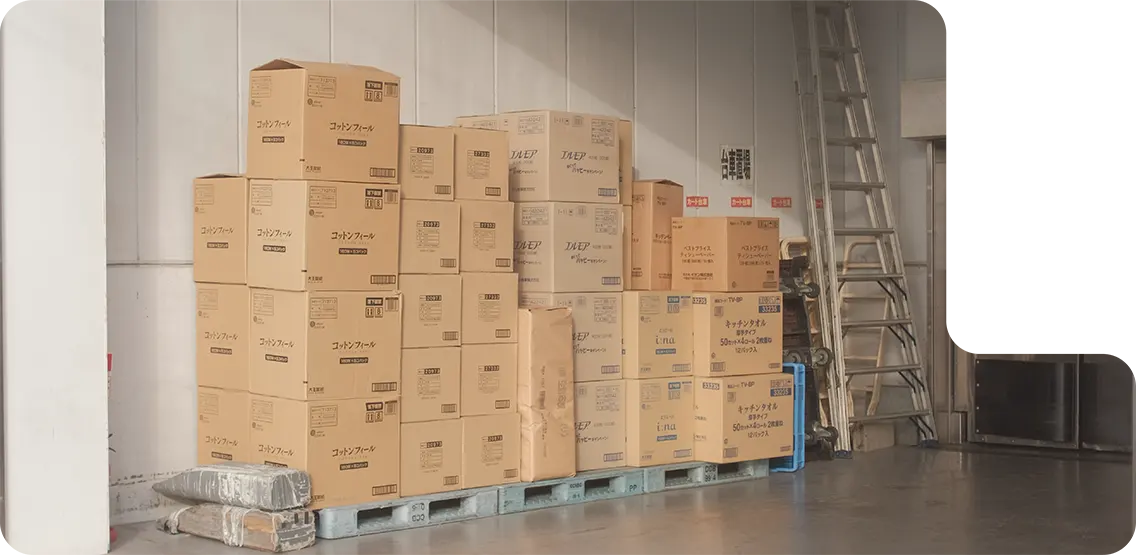Table of Contents
More Inventory Content
Subscribe to get the latest news!
Table of Contents
More Inventory Content
Share this
Subscribe to get the latest news!
Table of Contents
Share This
More Inventory Content
Subscribe to get the latest news!
The inventory management process or inventory process is an essential part of a business. Not only does it helps the company keep track of all of its inventory and run related processes smoothly, but it also contributes to customer satisfaction. For most businesses, their inventory is the most valued asset. They are required to manage it well if they want to protect their products, which is their core item. But inventory management is not just about correctly stacking and handling the finished products but also the raw materials and tracking all their movements.

What Is An Inventory Process?
Inventory management process, also known as IMP, is a part of the Supply Chain Management process, which is vital to any business. It refers to the multiple tasks of storing, ordering, selling, and using a business’s inventory most efficiently to ensure profit and customer satisfaction. Not only does this involve the proper management and warehousing of the finished products, but it also includes the management of raw materials and other components that go into making these products.
Monitoring inventory, from raw materials to finished products, is known as the inventory process or inventory management. Proper inventory management ensures no overabundance or shortage of products in the inventory, as both can harm the business. Your inventory needs the right amount of products depending on the market demand.

Why is an Inventory Process Important?
As we already mentioned before, inventory management is one of the critical processes in running a business, and you have to ensure you are doing it correctly. It is vital to your company’s health and customer relations.
Inventory management ensures that you never have too few or too many products at hand and only procure the raw materials you need to make the right product. It also helps you track and manage your storage and warehousing process to ensure all materials are safe and accessible. It lessens the risk of having inaccurate records and stockout. Accurate inventory control is crucial as not only does it saves cost but also improves customer relations. It makes the fulfillment process easy and hassle-free, thus cutting back on high inventory costs.
It also improves the cash flow in the business as you spend more money on the inventory that sells more, thus making a profit. Effective inventory management also makes sure that customers are never waiting for you to restock your items and can have the products they order in little time, thus improving customer satisfaction.
These are a few reasons why the inventory management process is essential for any business you might run. So you have to make sure that you have an efficient inventory management system that looks over the entirety of your inventory and manages it well.
Fundamentals of Inventory Accounting
Inventory management is a process through which all incoming raw materials and outgoing products are handled efficiently. The ultimate goal of an inventory management process is to find the perfect balance between the money you invest in the inventory and customer satisfaction. As it is a complicated process, a few steps are involved in inventory management. All inventory plans are generally built around these few steps.
- The first step is the products reaching the inventory or storage facility. Mostly this happens at a warehouse or fulfillment center. In a physical retail shop, usually, the products reach the stores in this step.
- These products are first inspected and then sorted and stored according to their needs. You can use a lot of different methods like dropshipping or cross docking. Whichever strategy you think fits your business perfectly, should be used in this step.
- Through a physical check on the inventory or by using software, all the inventory levels are monitored for optimum inventory planning.
- After this, when the customer places the order, the second level of inventory management starts. The customer can place the order through an online portal, which usually happens in e-commerce businesses.
- After the customer places the order, the business approves all orders. This happens through an automated process. If you plan to use dropshipping, you must pass these orders to your supplier or manufacturer, who will ship the products to your customer.
- After that, the fulfillment process begins, another vital part of the supply chain. The products are located in the storage facility, picked, packed, and shipped to the customer.
- After this, your inventory levels will be updated to show how many products are left in your inventory. If your product numbers are low, you can restock them as necessary. You can keep an eye on your inventory levels through a perpetual inventory program that many companies use. Alternatively, you can also monitor your stock levels manually.
- In the Just-in-time inventory model, the reorder point of each sell is calculated. This helps you get the goods and products needed to fulfill customer demands efficiently.

Types of Inventory Management Methods
Inventory management is a complex process, and it has a few types. Depending on the needs of the business and the types of products they provide for their customers, the companies can choose from these various inventory management methods.
Economic Order Quantity
In this method, the constant consumer demand is taken in to determine how many units a company will need to add to its inventory. It determines the number of products you need for your batch order to ensure you have a competent inventory. This helps lessen the inventory costs by a lot.
It helps your company because you will have a fair idea of the customer demand and stock your inventory according to that. It makes sure you do not have excess or absence of products in your inventory and still make the fewest number of orders to save cost and satisfy your customers. It can help a company minimize its holding and setup costs.
Just-In-Time
This inventory management model was first used in Japan in the 1960-70’s. It was mostly developed by Toyota Motors. This model can save your company a lot of money as it focuses on only keeping the inventory you will need to produce and sell a certain number of products. It is also conducive to reducing waste. But this management method runs a very high risk of f
Days Sales Of Inventory
Also known as DSI, this method is a ratio that shows how many days it takes on average for a business to turn its inventory. This also includes the products that are a work in progress. It takes into account many factors and data to come up with these numbers.
At the end of the day, it will be preferable if your company has a lower DSI because that will mean that the products are liquidating and being sold at a higher pace. This way, not only can you predict at which rate your inventory will sell, but it also helps you improve your sales rate.
Materials Requirement Planning
This inventory method is dependent on sales forecasts. This means it uses accurate sales data and records so that the manufacturer can use them to plan the inventory accurately beforehand. Then they can use the data to order the materials they need to make the inventory timely and orderly.
The MRP method is advantageous as it uses accurate data. Still, if there is a miscalculation in the forecast, then it can result in the manufacturer being unable to fulfill orders.

Warehouse Inventory Processes
The warehouse inventory process is a management method that ensures that the receiving, storing, and tracking of your inventory in a warehouse goes smoothly. It is imperative to manage your warehouse space and staff appropriately to ensure everything runs smoothly.
Because how your stock is handled and managed in a warehouse affects your business’s fulfillment process, shipping and transportation, and ultimately, your customers. It is essential to have an efficient warehouse inventory management method as it directly impacts customer satisfaction.

How to Improve the Inventory Management Process?
If you want your business to be successful and your supply chain to function smoothly, you need to improve your inventory management process. You might already have a sound inventory management system in place, but just a few tweaks can make a world of difference.
Here are a few tips on how to improve your inventory management process to be more efficient.
Setting a minimum stock level is easily one of the best methods to achieve a stable inventory. You can analyze all the available data and predict the customer demands as well, but no inventory is ever going to be just perfect. But if you set a minimum stock level for each item, you can easily track which ones are selling faster and order more of that item from a manufacturer.
A minimum stock level means keeping a minimum amount of stock of all the items in your inventory at all times, and when you see one item selling fast, you can order more from your manufacturer. This is one of the best ways to keep inventory as it will put much less pressure on the manufacturer, meet customer demands quickly, and make them happy. Customers will become loyal to your brand if they get satisfactory service and products.
Sometimes, there will be some very slow-selling products. They do not move out of the storage space and also cost money. If you have a lot of money tied up in this obsolete inventory, it will not only take up unnecessary storage space but also be bad for your business. Especially if the demand changes in the market and the products become too old to sell. It is easy for a company to focus only on the fast-moving inventory and forget about the rest, but do not forget that these also cost you money.
That is why you need to be in touch with your warehousing facility and try to remove these obsolete products before they become waste. Either organize periodic clearance sales to move them out or sustainably discard them if they are unusable. Either way, this will save you a lot of money you can use to improve your business and advertising.
One of the essential aspects of your business is the supply chain. The supply chain has many aspects and processes, one of which facing problems will weaken the whole process. Your supply chain network ties your entire business together, starting from the suppliers and ending with the final customer. Inventory management is dependent on how the supply and manufacturing processes of your supply chain work.
Otherwise, there will be delays and understocking of items in your inventory, which will result in customer dissatisfaction. Another aspect of this is transporting the products to the warehouse. Many things can go wrong in these complicated processes, and not all of them you can control.
However, if you have an efficient supply chain management method in place, then the risk of delays will be minimized, and your inventory management process will go smoothly. Remember that your inventory is dependent on the other aspects of your supply chain and vice versa. Optimize all the links in your supply chain to make your business efficient.
Conclusion
If you are running a business, you must improve your inventory management process; otherwise, you can suffer huge losses. Inventory management ensures that you have enough products in-store to satisfy the customers’ changing needs while also seeing that you do not overstock and lose money through inventory charges and possibly damaged and old products. That is why it is one of the integral management processes related to a business’s supply chain.
Sign up today and LEAVE THE LOGISTICS TO US
Sign up, and we will get back to you within 24 hours to discuss what services would be best for your business needs. Or speak with us now and tell us what you need.
FAQs
Inventory management is an instrumental part of any company’s supply chain, ensuring that all the company’s inventory is ordered, stored, and utilized efficiently.
Improving your entire supply chain process, liquidating slow-selling products, and always keeping minimum stock levels are all effective ways to improve your business’s inventory management process. You can find the details about these methods in the article.
Inventories are usually the most high-valued assets of any company. It also ensures that your products are safe and make customers happy. That is why properly managing your inventory is essential to running a business.
Just-in-time, Materials Requirement Planning, Economic Order Quantity, and Days Sales of Inventory are some of the best and most commonly used inventory management methods.
Inventory management is a significant part of supply chain management. It can directly affect the other processes like fulfillment and shipment in the supply chain. That is why these two are very closely related.